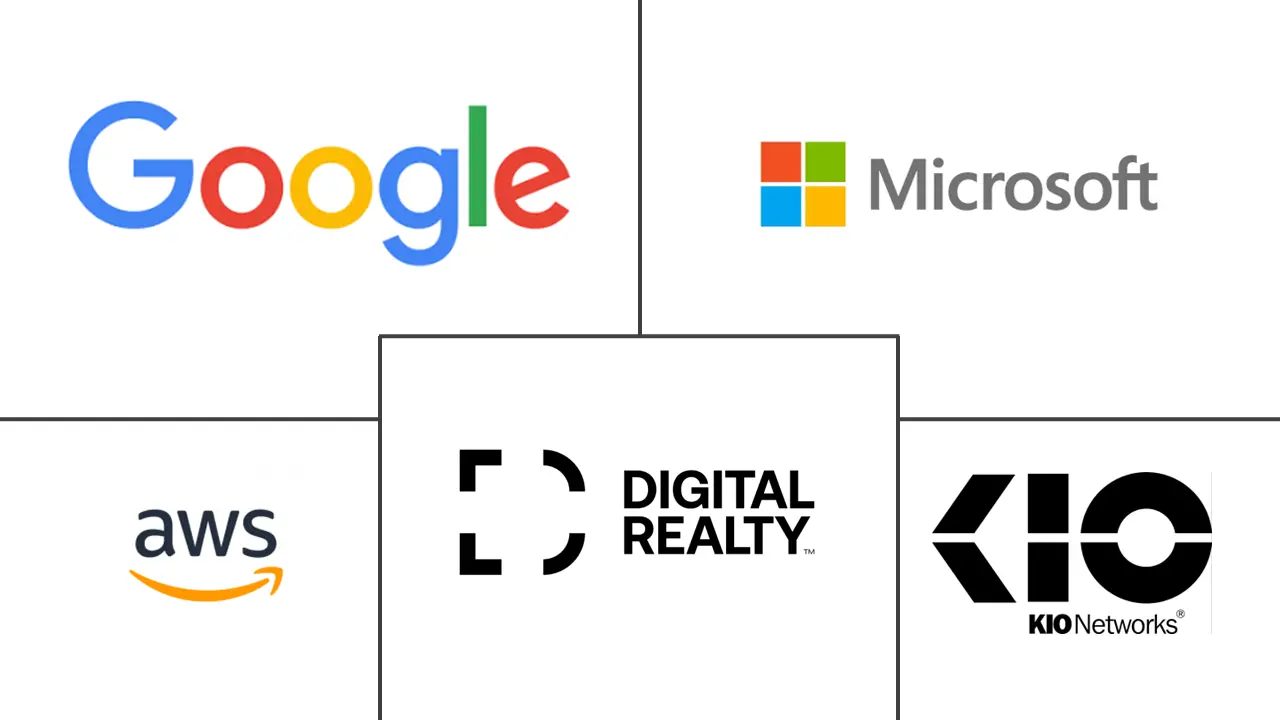Mexico Hyperscale Data Center Market Size and Share
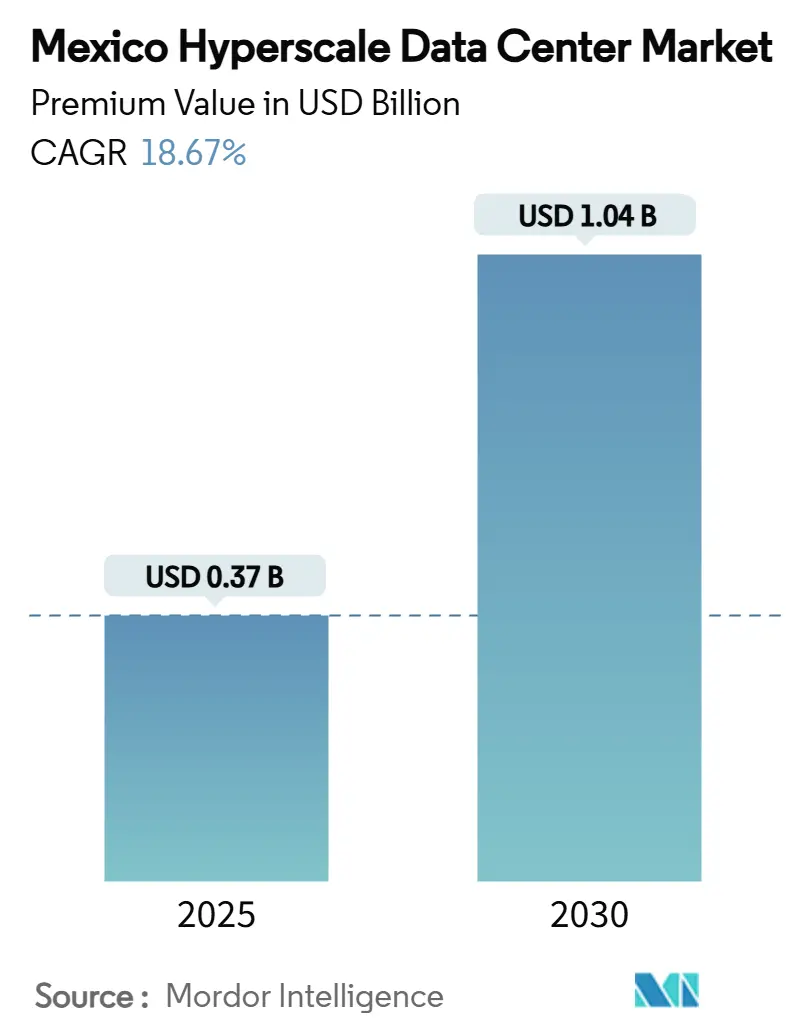
Mexico Hyperscale Data Center Market Analysis by Mordor Intelligence
The Mexico hyperscale data center market size stood at USD 0.37 billion in 2025 and is forecast to reach USD 1.04 billion by 2031, expanding at an 18.67% CAGR during the period. Installed IT load will climb from 361.02 MW to 546.09 MW, marking a 7.14% volume CAGR that mirrors deliberate capacity additions aligned with power-grid limits. Strong sovereign-cloud roll-outs, surging AI inference demand, and real-time payment modernization underpin growth, while water-use restrictions and component shortages temper near-term expansion. Querétaro anchors the Mexico hyperscale data center market, yet emerging hubs in Guadalajara and Durango diversify geographic risk. Competitive intensity stays moderate as global hyperscalers, international colocation providers, and domestic specialists pursue differentiated cooling and power strategies to win enterprise and AI workloads.
Key Report Takeaways
- By data center type, hyperscaler self-builds led with 59% of the Mexico hyperscale data center market share in 2024, while hyperscale colocation is projected to grow at 18.7% CAGR through 2030.
- By component, IT infrastructure accounted for 49% share of the Mexico hyperscale data center market size in 2024; liquid-cooling systems are advancing at a 19.47% CAGR to 2030.
- By tier standard, Tier III facilities held 70% revenue share in 2024, whereas Tier IV deployments post the fastest growth at 19.67% CAGR to 2030.
- By end-user, cloud and IT services captured 43% share of the Mexico hyperscale data center market size in 2024 and AI cloud providers will expand at a 21.17% CAGR through 2030.
- By data center size, massive sites (25-60 MW) led with 51% revenue share in 2024; mega facilities above 60 MW grow at 20.67% CAGR during the forecast window.
Mexico Hyperscale Data Center Market Trends and Insights
Drivers Impact Analysis
| DRIVER | (~) % IMPACT ON CAGR FORECAST | GEOGRAPHIC RELEVANCE | IMPACT TIMELINE |
|---|---|---|---|
| Exploding GPU-centric AI/ML workloads (US spill-over) | +4.2% | Querétaro, Mexico City, Guadalajara | Medium term (2-4 years) |
| Sovereign-cloud roll-outs by hyperscalers | +3.8% | National, concentrated in Querétaro | Long term (≥ 4 years) |
| Real-time payment mandates driving Tier IV builds | +2.1% | Mexico City, Monterrey, Guadalajara | Short term (≤ 2 years) |
| 5G edge–core consolidation boosting central Mexico hubs | +1.9% | Central Mexico corridor | Medium term (2-4 years) |
| GenAI inference campuses demanding liquid-cooling | +3.4% | Querétaro, emerging in Durango | Medium term (2-4 years) |
| Availability-based captive renewable PPAs in LATAM | +2.3% | Northern Mexico, Querétaro | Long term (≥ 4 years) |
| Source: Mordor Intelligence | |||
GPU-Centric AI Workloads Reshape Infrastructure Demands
AI inference spill-over from saturated U.S. markets drives record GPU cluster deployments, with Foxconn constructing a USD 500 million Nvidia superchip facility near Guadalajara that will feed regional data centers.[1]Kevin Parrish, “Foxconn builds Mexico plant for Nvidia as Chinese decoupling continues,” Tom's Hardware, tomshardware.com USMCA preferences allow 60% of Nvidia AI servers to enter the United States tariff-free after Mexican assembly, making the Mexico hyperscale data center market crucial for North American AI supply chains. Direct-to-chip liquid cooling cuts energy use up to 80% for GPU racks and supports densities forecast to hit 100 kW per rack by 2027.
Sovereign Cloud Mandates Drive Hyperscaler Localization
Amazon Web Services’ USD 5 billion Querétaro region, Microsoft’s Mexico Central region, and Google Cloud’s forthcoming Querétaro region respond to stricter 2025 data-residency rules that shift oversight to the Ministry of Anti-Corruption.[2]Reuters Staff, “Amazon's AWS to invest over $5 bln to boost cloud computing in Mexico,” Reuters, reuters.com Localized regions trim latency by 40-60 % for real-time apps and create durable demand across the Mexico hyperscale data center market.
Real-Time Payment Infrastructure Accelerates Tier IV Adoption
Banco de México’s instant-payment push compels banks to secure 99.995% uptime, raising Tier IV demand especially in Mexico City and Monterrey.[3]Uptime Institute Case Study, “KIO Networks – TIER-Ready Award,” Uptime Institute, uptimeinstitute.com BBVA’s cloud migration to AWS underscores the move of financial workloads into Tier IV hyperscale environments.
GenAI Inference Campuses Demand Advanced Cooling Solutions
NVIDIA’s Blackwell platform improves water efficiency 300-fold, validating liquid-cooling investments that post the highest CAGR among components. LiquidStack’s MicroModular units deliver 250 kW cooling without water, giving operators a path around looming water caps in Querétaro.
Restraints Impact Analysis
| RESTRAINTS | (~) % IMPACT ON CAGR FORECAST | GEOGRAPHIC RELEVANCE | IMPACT TIMELINE |
|---|---|---|---|
| Water-usage restrictions on evaporative cooling | -2.8% | Querétaro, Northern Mexico | Short term (≤ 2 years) |
| GPU/optic supply-chain bottlenecks | -3.1% | National, global supply chain dependent | Medium term (2-4 years) |
| Rising carbon levies and heat-tax proposals | -1.4% | National, Mexico City priority | Long term (≥ 4 years) |
| Local-grid curtailment caps >30 MW | -2.7% | Querétaro, industrial corridors | Medium term (2-4 years) |
| Source: Mordor Intelligence | |||
Water Scarcity Constrains Traditional Cooling Methods
Lake Constitucion’s drying highlights resource pressure; new facilities might consume 15 billion L of water yearly, sparking opposition and speeding adoption of zero-water designs like Microsoft’s 2026 roadmap and passive cooling breakthroughs that dissipate 800 W / cm² without added energy.
Supply Chain Vulnerabilities Threaten Deployment Timelines
Scarce H100 GPUs and 800 G optics extend lead times, curbing near-term rack activation across the Mexico hyperscale data center market. Operators respond by pre-positioning inventory and qualifying secondary vendors, which raises working-capital needs and complicates project schedules
Segment Analysis
By Data Center Type: Self-Build Dominance Faces Colocation Challenge
Self-built facilities held 59% of 2024 revenue, reflecting hyperscalers’ need for custom architecture and strict control. The largest single project is AWS’s Querétaro campus, part of a USD 5 billion spend that elevates the Mexico hyperscale data center market size for self-builds. Nevertheless, hyperscale colocation grows 18.7% CAGR as KIO Networks and ODATA offer turnkey halls that shorten deployment cycles. These providers embed sovereign-cloud compliance and liquid-cooling readiness, allowing smaller cloud and edge tenants to tap enterprise-grade facilities quickly. In the second half of the forecast, hybrid models—where a hyperscaler leases entire buildings inside a colocation campus—blur category lines yet keep the overall Mexico hyperscale data center market on a steady growth path.
The colocation surge benefits telecom and content delivery networks seeking carrier-neutral meet-me rooms. Equinix’s USD 175 million acquisition of three Axtel sites expands cross-border connectivity and validates colocation economics. Rising land prices in Querétaro may push late entrants toward colocation deals in Guadalajara and Durango, spreading capital expenditures and mitigating grid-connection delays. As self-build plots become scarce, the Mexico hyperscale data center market expects a gradual re-balancing toward shared-infrastructure models without erasing the control advantages that continue to justify hyperscaler campuses.
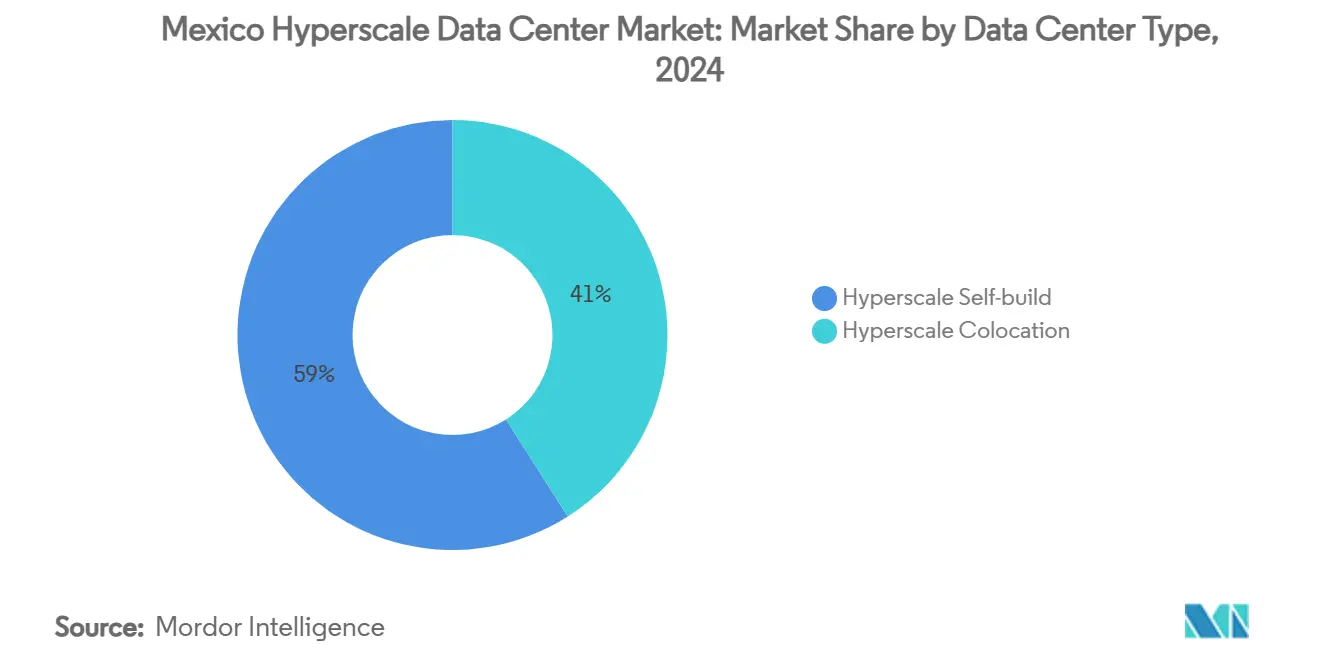
By Component: IT Infrastructure Leadership Challenged by Cooling Innovation
Servers, storage, and networking retained 49% revenue in 2024, underpinned by mass GPU cluster roll-outs for AI. Local production of NVIDIA GB200 superchips by Foxconn will improve component availability and lower import costs, strengthening domestic value chains. Yet liquid-cooling hardware posts the top CAGR at 19.47%, propelled by rack densities that legacy air systems cannot support. LiquidStack’s sealed immersion tanks and Supermicro’s rack-scale solutions cut energy use 40% while enabling >2.5 kW chips.
Electrical infrastructure—UPS, switchgear, and backup generators—sees steady, grid-linked growth, whereas mechanical plant beyond cooling expands modestly. General construction services gain from greenfield builds that embed seismic isolation and closed-loop water reuse features. Over the forecast, liquid-cooling share could approach 15% of the Mexico hyperscale data center market size, creating procurement shifts toward specialized pump, manifold, and coolant suppliers.
By Tier Standard: Tier III Dominance Yields to Tier IV Acceleration
Tier III remained the mainstream at 70% revenue in 2024, balancing cost and redundancy for typical cloud and content workloads. Uptime Institute certifications on existing KIO sites reinforce operator maturity. Yet Tier IV deployments grow 19.67% CAGR, a pace tied to Banco de México’s real-time payment agenda and higher regulatory penalties for downtime. HostDime’s 100,000 ft² Tier IV site in Guadalajara shows that diversified geography plus top-tier reliability now outweigh incremental capex.
Financial services, e-commerce, and AI inference platforms that monetise real-time services anchor early Tier IV demand. Advanced facilities integrate dual liquid-cooling loops, on-site solar, and battery energy-storage systems to pass stricter availability audits. By 2031, Tier IV could exceed 25% share of the Mexico hyperscale data center market, signaling an availability-driven shift similar to mature North American peers.
By End-User Industry: Cloud Services Lead While AI Providers Surge
Cloud and IT services occupied 43% revenue in 2024 as enterprises executed lift-and-shift migrations to localized regions. Multinational banks extended European cloud blueprints into Mexican operations, reinforcing cloud core dominance. AI cloud providers post the fastest 21.17% CAGR, a rate fueled by global model-hosting firms deploying inference clusters to serve Latin America. Their power-density needs accelerate liquid-cooling adoption inside the Mexico hyperscale data center market.
Telecom operators remain steady customers because 5G roll-outs demand edge interconnects and low-latency core links. Media firms push high-bit-rate CDN caching into Querétaro to support regional streaming. Government agencies adopt cloud-first policies once sovereign-cloud regions clear compliance hurdles. Manufacturing, e-commerce, and healthcare round out the demand base, each benefiting from predictable cost structures that hyperscale economics enable.
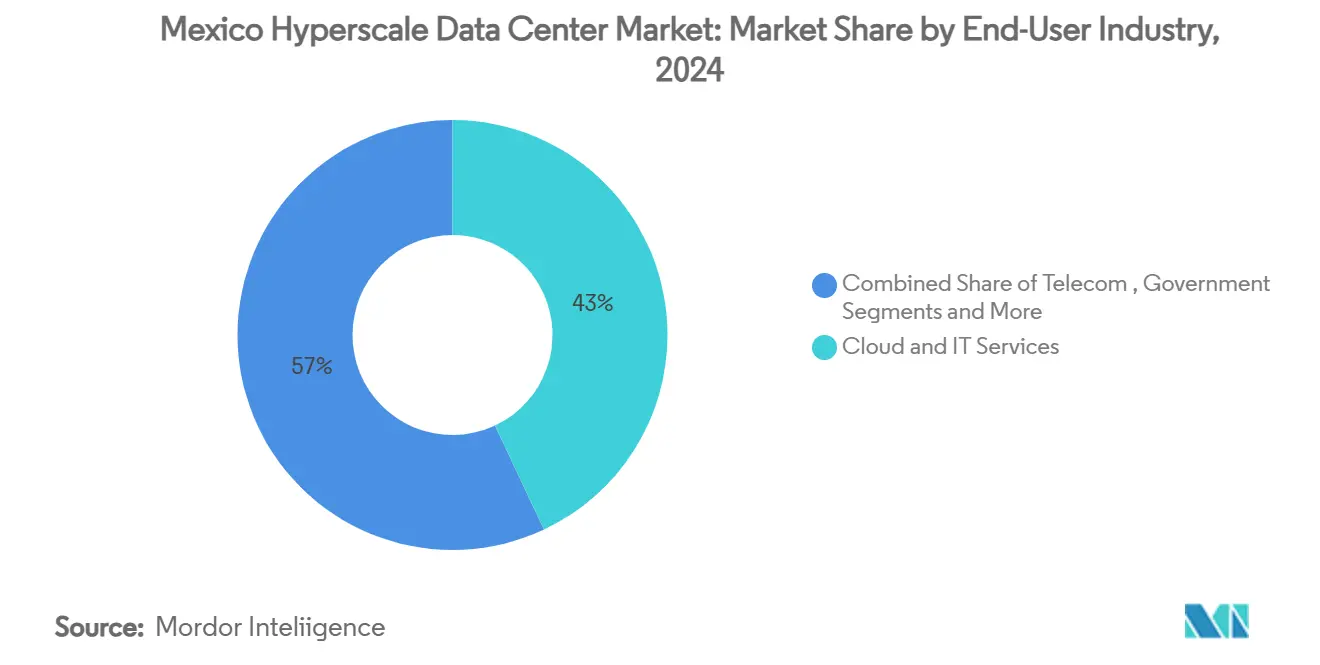
Note: Segment shares of all individual segments available upon report purchase
By Data Center Size: Massive Facilities Dominate as Mega Deployments Accelerate
Sites between 25 MW and 60 MW held 51% revenue in 2024, balancing grid connection ease and economies of scale. CloudHQ’s USD 725 million Querétaro campus typifies the category, aligning with state infrastructure and offering phased blocks for future growth. Mega facilities above 60 MW record a 20.67% CAGR, leveraging captive power such as natural-gas turbines or small modular reactors to bypass curtailment caps. Durango’s announced 250 MW campus, among the largest in Latin America, demonstrates the frontier of scale achievable in the Mexico hyperscale data center market.
Large facilities ≤ 25 MW still serve edge and enterprise colocation but will lose share as AI builds favor bigger footprints. Grid-constraint workarounds, like dual-feed substation build-outs and onsite renewables, become mandatory at mega sites. These technical shifts usher the market from a regional edge-support role toward a continental traffic-aggregation function.
Geography Analysis
Querétaro hosts the densest cluster with more than USD 10 billion in committed investments and a pipeline that could lift capacity from 160 MW to 600 MW within six years. Low seismic risk, stable power, and fiber aggregation explain the concentration, though new water caps spur interest in alternative sites. Mexico City stays pivotal for financial workloads and network peering, reinforced by Tier IV builds that answer uptime mandates.
Guadalajara leverages its electronics manufacturing base to attract both self-build and colocation projects; Foxconn’s superchip plant creates a semiconductor hub that feeds adjacent data centers. The city’s universities supply skilled technicians, keeping operational costs competitive. Monterrey acts as a cross-border conduit where KIO’s MTY2 facility enhances interconnection with Texas carriers, serving enterprises that split workloads across both sides of the border.
Durango’s 250 MW natural-gas campus signals a new north-west corridor, pairing abundant land with dedicated power to sidestep Querétaro’s grid caps. Northern border locations such as Tijuana and Ciudad Juárez retain niche relevance for latency-sensitive edge nodes but face grid and water headwinds. Collectively, these dynamics diversify the Mexico hyperscale data center market, distributing risk while sustaining its overall growth trajectory.
Competitive Landscape
Global hyperscalers AWS, Microsoft, and Google anchor demand through sovereign-cloud regions. Each aims to differentiate on renewable-energy sourcing and liquid-cooling efficiency. Their combined commitments exceed USD 7 billion, establishing an investment benchmark that shapes the Mexico hyperscale data center market.
International colocation leaders Equinix and Digital Realty expand through acquisitions and joint ventures. Equinix leveraged its Axtel purchase to secure carrier-neutral status and accelerate time-to-market for enterprises. Domestic champion KIO Networks competes on local regulatory know-how, partnering with Caribbean operators to broaden reach. Niche builders such as CloudHQ and ODATA focus on single-tenant hyperscale halls, while HostDime targets premium Tier IV specifications for financial and healthcare clients.
Technology differentiation intensifies around cooling IP. CoolIT has amassed 50 patents, signaling a proprietary race that could lock customers into vendor ecosystems. Renewable power procurement, including availability-based PPAs, also becomes a key tender variable as operators respond to rising carbon levies. Despite the expanding roster of entrants, the top five players still command a majority of installed megawatts, keeping the Mexico hyperscale data center market moderately concentrated yet competitively fluid.
Mexico Hyperscale Data Center Industry Leaders
-
Amazon Web Services, Inc. (AWS)
-
Microsoft Corporation
-
KIO Networks
-
Google, Inc.
-
Digital Realty (Ascenty)
- *Disclaimer: Major Players sorted in no particular order
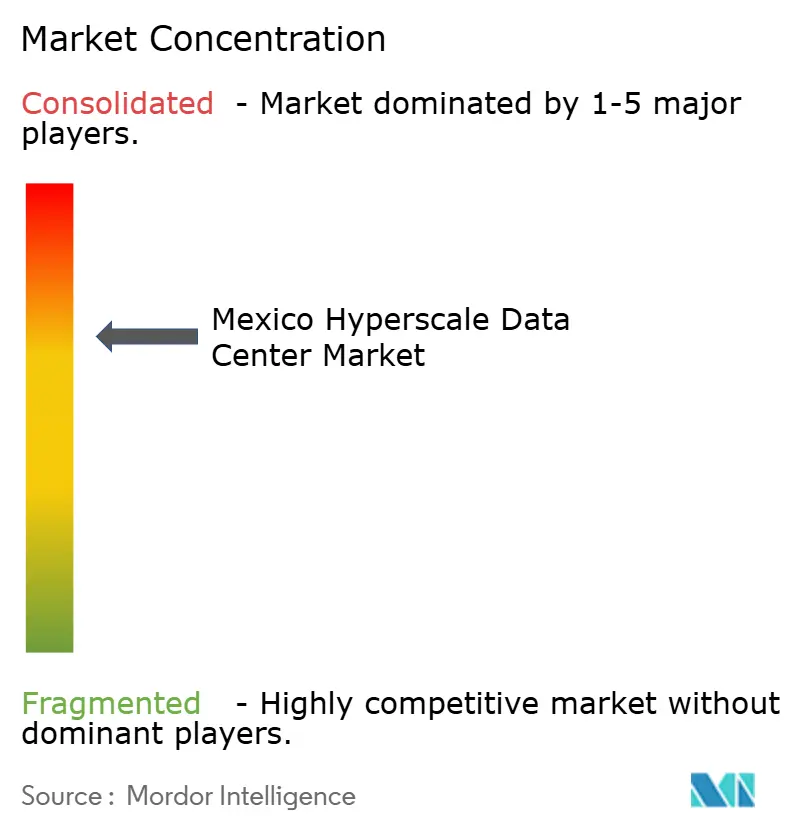
Recent Industry Developments
- January 2025: Amazon Web Services announced a USD 5 billion investment to establish its first cloud region in Querétaro, Mexico, featuring three availability zones and water-efficient cooling systems. The project is expected to add USD 10 billion to GDP over 15 years and create 7,000 annual jobs across sectors.
- January 2025: CloudHQ broke ground on power infrastructure for its USD 725 million hyperscale campus that will create 1,000 jobs in Querétaro.
- January 2025: KIO Data Centers joined the Caribbean Datacenter Association to enhance regional collaboration.
- December 2024: MDC Data Centers entered Mexico with its first proprietary facility, marking further international interest.
Research Methodology Framework and Report Scope
Market Definitions and Key Coverage
Our study defines Mexico's hyperscale data center market as all newly built or fully leased facilities that exceed 20 MW of IT load and are owned or long-term leased by major cloud and digital service providers; revenue reflects capital investment plus first-fill IT equipment and critical infrastructure services.
Scope exclusion: colocation halls serving multiple tenants, edge pods below 5 MW, and managed on-premise server rooms are outside this valuation.
Segmentation Overview
- By Data Center Type
- Hyperscale Self-Build
- Hyperscale Colocation
- By Component
- IT Infrastructure
- Server Infrastructure
- Storage Infrastructure
- Network Infrastructure
- Electrical Infrastructure
- Power Distribution Units
- Transfer Switches and Switchgears
- UPS Systems
- Generators
- Other Electrical Infrastructure
- Mechanical Infrastructure
- Cooling Systems
- Racks
- Other Mechanical Infrastructure
- General Construction
- Core and Shell Development
- Installation and Commissioning Services
- Design Engineering
- Fire Detection, Suppression and Physical Security
- DCIM / BMS Solutions
- IT Infrastructure
- By Tier Standard
- Standard
- Tier III
- Tier IV
- By End-User Industry
- Cloud and IT
- Telecom
- Media and Entertainment
- Government
- BFSI
- Manufacturing
- E-Commerce
- Other End-User
- By Data Center Size
- Large ( Less than or equal to 25 MW)
- Massive (Greater than 25 MW and Less than equal to 60 MW)
- Mega (Greater than 60 MW)
Detailed Research Methodology and Data Validation
Primary Research
Mordor analysts interviewed facility engineers, regional utility planners, and cloud procurement leads across Queretaro, Mexico City, and Guadalajara. These discussions validated construction timelines, rack densities, and average selling prices, and they clarified local grid connection bottlenecks that rarely appear in documents.
Desk Research
We collated baseline signals from open sources such as Mexico's Secretaria de Energia power capacity releases, Instituto Federal de Telecomunicaciones spectrum filings, import-export shipment records from Volza, and data center land bank disclosures filed with CNBV. Trade associations like CANIETI and global cloud service environmental reports enriched our understanding. Select paywalled datasets, D&B Hoovers for hyperscale balance sheet clues, Dow Jones Factiva for project pipelines, and Marklines where automotive AI loads intersect, added depth. The sources cited illustrate our approach; many additional references informed model calibration.
Market-Sizing & Forecasting
We begin with a top-down reconstruction of hyperscale CAPEX using Secretaria de Hacienda building permit values, cross-checked against power connect approvals and average $/MW benchmarks. Supplier roll-ups of switch gear shipments and sampled GPU rack ASP × volume provide a bottom-up sense check before totals are adjusted. Key variables like grid interconnection queue, sovereign cloud mandates, AI GPU uptake, PPA renewable premiums, and exchange rate paths drive the model. Multivariate regression on these inputs, supplemented by ARIMA to smooth cyclical build waves, underpins forecasts through 2031.
Data Validation & Update Cycle
Outputs undergo variance scans versus satellite imaged construction footage and CBRE quarterly absorption data; anomalies trigger re-interviews before senior review. Models refresh annually, with interim updates when energy policy or hyperscaler CAPEX announcements materially shift the outlook.
Why Our Mexico Hyperscale Data Center Baseline Commands Reliability
Published estimates often diverge because firms mix hyperscale builds with colocation halls, apply different ASP ladders, or freeze exchange rates at publication.
Key gap drivers include wider scope (others add enterprise and edge sites), aggressive roll forward of global GPU cost curves without Mexico specific checks, or infrequent refresh cycles that miss 2024 power quota caps. Mordor's disciplined geographic scoping, dual path validation, and annual refresh cadence mitigate these distortions.
Benchmark comparison
| Market Size | Anonymized source | Primary gap driver |
|---|---|---|
| USD 0.37 B (2025) | Mordor Intelligence | - |
| USD 2.38 B (2023) | Global Consultancy A | Includes colocation and enterprise builds; limited Mexico field verification |
| USD 5.18 B (2023) | Regional Consultancy B | Rolls hardware, software and services together; top down LATAM allocation |
| USD 2.5 B (2023) | Trade Journal C | Conservative estimate from aggregated press releases; no IT load normalization |
In sum, Mordor Intelligence delivers a balanced, transparent baseline rooted in Mexico specific permits, power data, and stakeholder insights, giving decision makers a figure they can confidently trace and replicate.
Key Questions Answered in the Report
What is the current value of the Mexico hyperscale data center market?
The market is valued at USD 0.371 billion in 2025 and is projected to climb to USD 1.036 billion by 2031.
Which Mexican state hosts the largest cluster of hyperscale data centers?
Querétaro hosts the majority of current and planned capacity due to stable power, fiber density, and low seismic risk.
Why is liquid cooling gaining traction in Mexican data centers?
AI-driven rack densities exceed what air cooling supports, and liquid systems cut energy use up to 80% while meeting water-use caps.
How fast is the Tier IV segment growing?
Tier IV facilities are forecast to expand at a 19.67% CAGR, driven by real-time payments and stricter uptime mandates.
What share do self-built campuses hold in the market?
Self-build projects commanded 59% revenue share in 2024, though colocation is growing quickly at 18.7% CAGR.
Which end-user segment will grow the fastest through 2030?
AI cloud providers lead with a 21.17% CAGR as global inference networks expand into Mexico.
Page last updated on:
